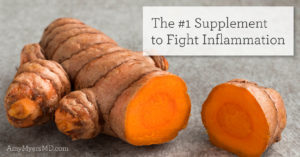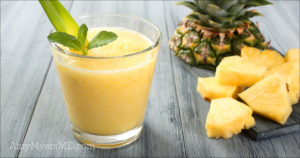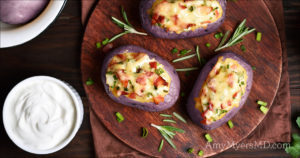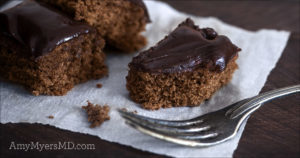Amy Myers's Blog, page 47
February 12, 2019
The #1 Supplement to Fight Inflammation


Inflammation is the root cause of a very long list of chronic diseases and conditions. It plays a key role in Alzheimer’s disease, cardiovascular disease, metabolic syndrome, arthritis, diabetes, obesity, depression, and fatigue.1,2,3 It’s involved in nearly every modern chronic illness, including many autoimmune diseases. In fact, the more inflammation you have, the further along the autoimmune spectrum you’re likely to be.
When your immune system is working optimally, acute inflammation is a critical weapon that protects you against severe and immediate stressors—for example, fighting off a bacterial infection or healing a wound. This type of inflammation is localized (think a sore throat or red, inflamed skin around a cut), and subsides once the threat is gone.
However, chronic inflammation in your body is a big problem. Chronic inflammation is systemic and ongoing, and puts your body in a state of constant alert. This type of inflammation sets you on the path to chronic illness and/or autoimmune disease, and absolutely must be addressed for your return to optimal health. Where does chronic inflammation come from? Learn the top 5 sources of inflammation in this article.
To fight inflammation at its source, I first recommend changing your diet and lifestyle, including eating anti-inflammatory foods, repairing your gut, reducing your toxic burden, healing your infections, and relieving your stress.
My next weapon against inflammation is curcumin, an extremely potent free-radical fighting compound that naturally occurs in the spice turmeric. Curcumin is capable of stopping inflammation in its tracks and offers a huge range of benefits you can enjoy no matter what level of inflammation your body experiences. Let’s explore exactly what curcumin is, and then I’ll get into why it’s my #1 supplement to fight inflammation.
What is Curcumin?
Curcumin is one of the three main active compounds, or curcuminoids, that give turmeric its bright yellow color, alongside demethoxycurcumin and bisdemethozycurcumin.4
Curcumin has recently soared in popularity for its free radical-fighting and anti-inflammatory qualities. However, turmeric has a long history of use in Ayurvedic medicine as a treatment for inflammatory conditions. It has been used topically on the skin for wounds, acne, and parasitic infections; administered orally for colds and urinary tract diseases; and even inhaled for chronic rhinitis and inflammation in the nose due to hay fever.5 It is used in curries in India, as an antiseptic in Malaysia, served in drinks in Korea, and added to cheese, butter, and mustard for color in the U.S.6
Curcumin makes up 90% of the curcuminoid content in turmeric, though turmeric is only around 5% curcuminoids by weight. This means that to get any benefit from the curcumin that occurs in turmeric, you’d practically have to eat nothing BUT turmeric. Consuming the extract in the form of a supplement is the best way to enjoy the full benefits of curcumin.7
The Anti-Inflammatory Benefits of Curcumin
Curcumin has been shown to help fight inflammation thanks to its many powerful properties.It has also been shown to reduce oxidative stress.8 This is important because inflammation can lead to oxidative stress, and vice versa.9,10
Curcumin relieves inflammation in a number of different ways, including:
Increasing the activity of antioxidants in your body, such as superoxide dismutase (SOD), glutathione peroxidase (GSH) and lipid peroxides.11,12
Scavenging various forms of free radicals, including reactive oxygen and nitrogen species.13
Inhibiting certain enzymes, such as lipoxygenase/cyclooxygenase and xanthine hydrogenase/oxidase.14,15
Acting in the same way as the chain-breaking antioxidant Vitamin E, scavenging free radicals and breaking them apart so they can be transported out of your body as waste.16
A primary reason why curcumin is thought to be a powerful ally against inflammation is that it has the ability to seek out certain types of molecules in your body and inhibit them.17
One of these molecules is nuclear factor (NF)-kB, which is activated by environmental pollutants, cigarette smoke, certain types of bacteria, disease-causing viruses, stress on a physical, psychological and chemical level, and other disease-causing factors. Curcumin has been shown to block NF-kB activation.
What’s more, curcumin has been shown to inhibit or blockade other substances and pathways involved in inflammation and used by the immune system, including platelet-activating factor, prostaglandin E2, and others.18
Curcumin & Chronic Disease
There is a TON of research on curcumin. Did you know it supports normal inflammation levels, optimal cognitive function, your cardiovascular system, and overall health even if you’re dealing with a chronic illness such as autoimmune disease and arthritis? Let’s go deeper.
Autoimmune Diseases
Curcumin directly supports maintenance of your body’s immune system. This means it could be a key substance for you to explore if you’re struggling with multiple sclerosis, inflammatory bowel disease, or another autoimmune condition.
Arthritis
Arthritis sufferers often take a lot of NSAIDS, which are notorious for damaging your liver and intestinal lining. Unlike NSAIDs, curcumin has been found to be safe even at high doses, such as 1125-2500 mg per day. It is also thought to be safe for long-term use. This is understandable, since the average intake of curcumin in India, where it’s used extensively in cooking, is 60-100 mg, daily!
Brain Health
Inflammation and oxidative stress play a major role in the deterioration of cognitive function. This is so important as you age! Think about the older folks you know! Curcumin has been shown to support strong vascular tissue in the brain and to squash free radicals that cause inflammation in your brain. This is so important if you want to maintain memory and nimble mental activity.
Heart Health
Cardiovascular health relies on so many diverse factors, and curcumin is thought to be able to support heart health in a variety of ways. Who doesn’t need a healthy heart? Curcumin may support the function of the lining of your blood vessels just as well as exercise does!
Metabolic Issues
Metabolic issues are so prevalent in our society, especially given the Standard American Diet, or SAD. Your metabolic health involves everything from your blood sugar to your cholesterol levels. Thankfully, curcumin supports all of these areas and more. Research shows curcumin supports a healthy and normal insulin response, normal blood sugar levels, and healthy “good” cholesterol in your body.
The Best Way to Add Curcumin
As I mentioned above, turmeric contains very little curcumin, which is why taking a supplement is the most efficient way to reap all the benefits it can offer. In addition, another important piece of the puzzle you need to consider is that your body struggles to absorb this powerful substance.
My new Liposomal Curcumin tackles both these issues. First, I’ve ensured the ideal potency. Each two-teaspoon dose is packed with 500mg of naturally derived curcumin without the artificial sweeteners or additives that may be found in other brands.
I then took things a giant step forward by creating a delicious liquid, liposomal formula for the greatest possible bioavailability. Let me explain. A liposome is a microscopic pocket of fat that forms a protective, single-cell layer around the curcumin. This micelle, or thin layer, allows the curcumin to travel to the small intestine and into the bloodstream, so it can be delivered throughout your body directly to your cells that need it.
With typical curcumin supplements, the desirable nutrients are often not combined with a fat, nor are they in a form that can survive digestion. These inferior types of curcumin are very likely to be oxidized, neutralized, and even expelled before they can do any good at all. However, in my Liposomal Curcumin, the liposome, or fat pocket forms a protective coating that survives digestion, and also provides the fat that your body needs to process the curcumin.
With all the research on curcumin—and this is one of the most-studied supplements in the world—it’s clear it has incredible potential to impact your health in a positive way. It is shown to support normal inflammation levels, optimal cognitive function, your cardiovascular system in general, and your overall health even if you’re dealing with chronic illnesses such as autoimmune disease and arthritis.
Curcumin is my first choice for fighting inflammation and supporting my everyday wellness. Whether you’re looking to tackle the inflammation behind your chronic illness, slow aging, or reduce your reliance on harsh medications, the proven benefits of curcumin are extensive. Why not make it part of your daily routine, too?
The post The #1 Supplement to Fight Inflammation appeared first on Amy Myers MD.
February 11, 2019
Sunshine Smoothie


My Sunshine Smoothie brings a tropical tang to the table so that you can feel like you’re on vacation without even leaving the kitchen. Do you want to know what my favorite part about this smoothie is? There’s an ingredient with some incredible benefits hiding behind all of the delicious fruit. Liposomol Curcumin.
Liposomal Curcumin is the most bioavailable form of curcumin on the market. It supports a healthy inflammatory response and fights free radicals. My Liposomal Curcumin has a zesty citrus flavor that tastes great and actually works! It’s a turmeric supplement that is perfect for relieving occasional aches and pains caused by inflammation or dealing with gut or immune issues.
Most turmeric supplements on the market don’t contain enough of the bioactive components of turmeric that offer all of the wonderful health benefits. Turmeric root is only 2-5% curcuminoids by weight, and is also low in the essential oil compounds. My liquid Liposomal Curcurmin is the world’s most absorbable turmeric supplement, with a potency of 500mg of real, naturally extracted curcumin per serving.
So if you’re looking for a tasty smoothie with lots of protein, delicious flavor, and some additional inflammation-fighting power, you’ve found it!
Sunshine Smoothie

Course
Beverage, Breakfast, Snack
Protocol
Autoimmune Solution (AIP), Elimination Diet, Paleo, Thyroid Connection
Servings
1
Ingredients
1/2 cup frozen mango1/2 cup frozen pineapple1 scoop The Myers Way Vanilla Protein Powder1 tsp Liposomal Curcumin1/2 cup ice3/4 cup water or liquid of choice (coconut milk, pineapple juice, etc)
Servings:
Units:
MetricUS Imperial
Instructions
Place all ingredients in high-speed blender and blend until desired consistency is reached.
The post Sunshine Smoothie appeared first on Amy Myers MD.
February 10, 2019
The Gut-Skin Connection


Beautiful, glowing skin is a huge confidence booster. However, the opposite is also true. Skin that is flaky and dry, or peppered with unsightly blemishes can make even the idea of leaving the house seem overwhelming.
We have all experienced pimples, rashes, or other skin issues at some point in our lives and we’ve been taught to think that these issues are caused by infrequent washing, naturally oily skin, or not using this season’s miracle cream. This is simply not true. Beautiful skin is within everyone’s reach. And since you’re reading this article, that also means you too! Yes, if you take charge of your overall health—and seek to get to the root cause of the problem—your skin can be fresh, smooth, and unblemished.
However, if you don’t take some simple steps, dry patches, pimples, blemishes, and other issues can become part of your everyday reality. You may even be paving the way for more serious skin problems, including eczema, psoriasis, cystic acne, rosacea, and even fungal infections.
Your skin is the largest organ in your body, your first defense against the outside world. It is directly connected to your whole-body health. Your gut regulates your immune system. In fact, 70 to 80% of your immune system is located in your gut, so when your gut is healthy, you are well protected!2 So what’s the connection? In this article I’ll uncover the critical link between your skin and your gut, and how you can use this association to achieve vibrant health and radiant skin.
The Skin-Gut Axis
In some ways, your gut and your skin play similar roles. Both defend your body against pathogens, and both are covered in beneficial bacteria when in a healthy state.3 In fact, your gut contains between 300 and 500 bacteria species. The more diverse the mix, the better.4 This also applies to your skin. Studies show that certain strains of bacteria found on your skin are associated with acne reduction, skin hydration, elasticity, and maintaining the your skin’s overall health.5
Your gut’s job is to keep toxins, infections, and inflammation at bay. Your skin is the major detoxifier that helps eliminate the substances and waste created during this standoff. This connection and relationship is called the skin-gut axis.6 When the gut is not functionally optimally, it can result in issues throughout the body, even to the point of autoimmune disease. The skin is often the first place to show the effects of an unhealthy gut.
In fact, virtually every patient I saw in my clinic who came to me with a chronic skin condition had underlying Candida overgrowth. This is a condition in which the normally occurring yeast in your gut grows out of control. It breaks down the wall of your intestine and penetrates the bloodstream, releasing toxic byproducts into your body. Several studies suggest that people with psoriasis are more likely to have Candida colonize in their body. It is thought that substances called “super antigens” and toxins from species of Candida can worsen psoriasis symptoms. Additionally, a study in Clinical & Experimental Allergy found that Candida exposure exacerbated certain skin lesions such as eczema. And of course nail fungus, ringworm, tinea versicolor, jock itch and dandruff are known fungal infections. These are typically not just local infections; they are a result of underlying yeast overgrowth in the gut.
Another powerful gut-skin connection I often saw in my clinic is the rosacea – SIBO (Small Intestinal Bacterial Overgrowth) connection. Most of your gut bacteria is meant to be located in your large intestine and colon, where they help to break down food, synthesize vitamins, and eliminate waste. When these “good” bacteria colonize the small intestine, SIBO occurs. SIBO can also be caused by an overgrowth of otherwise normal bacteria in the small intestine itself.
I had so many patients who saw dermatologist after dermatologist for their rosacea with no improvement. After I treated their SIBO their rosacea completely vanished. My experience has been backed up by a recent clinical study. Researchers found that 46% of rosacea patients tested positive for SIBO, and that patients with rosacea were nine times more likely to have SIBO than patients without rosacea. How exactly does a gut infection lead to facial redness and irritation? SIBO damages gut lining, causing leaky gut, which leads to the release of pro-inflammatory cytokines (regulators of host immune responses that promote inflammatory reactions) resulting in skin inflammation.
Your gut can also communicate with your skin. The absorption of nutrients has a direct effect on your skin health, as do hormonal changes that change your skin on a physiological level. One example is that your skin can become tinted orange if you drink too much carrot juice. Studies show that this occurs because the carotenoids in fruits and vegetables get carried to your skin, where they can accumulate.7,8 There is also evidence that eating more refined carbohydrates could increase your risk of developing acne because increased insulin levels can stimulate oil gland production.9
In an ideal situation, your healthy gut will be reflected in your beautiful skin. A healthy gut will even synthesize extra vitamins and minerals that benefit your skin, such as the B vitamins thiamine and riboflavin.10
When Your Skin is Compromised
Healthy skin free from cuts and burns can also help you maintain a healthy gut and immune system. Studies show that burns and cuts affect your gut bacteria. One recent study showed that burn injuries actually increase the permeability of your gut and cause bacteria to move from your intestines into your bloodstream and other areas.11 Burns can also change the mix of bacteria in your body, allowing for Gram-negative aerobic bacteria overgrowth, such as E-coli and Salmonella, which can lead to infections.12 After a scald, your gut also responds to prevent immune suppression.13
What’s more, even a paper cut can affect your microbiome. When this happens, bacteria colonize in your wound.14 Studies show that chronic wounds are hosts to complex communities of microbes comprised of a much wider variety of species of bacteria that scientists have ever realized.15
Healthy Skin Inside…
Your gut is just one layer thick. Its cells, like the ones on the outer layer of your skin, can be replaced very quickly, so healing can be an accelerated process. This means that once you get to the root of the problem, you can get fast results inside and out.
I recommend removing irritants that can cause gut inflammation. The best way to do this is by completing an elimination diet to determine your personal food sensitivities. The goal is to get rid of things that negatively affect the environment of the GI tract including gluten, dairy, corn, soy, eggs, and sugar that can lead to food sensitivities.
You’ll also want to restore your gut health with digestive enzymes, and my Leaky Gut Revive , which helps nourish your gut cells.
, which helps nourish your gut cells.
Reinnoculating your gut with beneficial bacteria to re-establish a healthy balance of good bacteria is critical. This may be accomplished by taking a probiotic supplement that contains beneficial bacteria such as bifidobacteria and lactobacillus species. I advise taking my 100 Billion Probiotic, which contains a potent blend of four proven strains of beneficial bacteria.
Providing the nutrients necessary to help the gut repair itself is essential. One of my favorite supplements is collagen which is rich in amino acids that quite literally, “seal the leaks” or perforations in your gut by healing damaged cells and building new tissue. Another one of my favorite supplements is L-glutamine, an amino acid that helps to rejuvenate the gut wall lining.
Taking a multivitamin can also ensure you’re receiving adequate levels of skin-beautifying vitamins and minerals for a glowing appearance. The Myers Way Multivitamin® is one of four essential supplements I recommend everyone takes. It provides the nutrients needed for glowing skin, and helps neutralize the deficiencies that may be preventing you from moving forward with your gut and skin health.
Drinking filtered water is the best way to stay hydrated. How much should you be drinking? Try taking your weight in pounds, dividing it in half, and drinking that many ounces of water every day. Be sure to take a water bottle with you when you leave the house, so you’re never caught out while on the go.
…and Out
Vitamin D supports skin cell growth, repair, and metabolism, so plan to optimize your levels by spending time outside daily. Just don’t forget to apply a natural sunscreen to prevent your skin from damage if you’re going to be outside for extended periods of time or you have fair skin. A supplement can ensure you don’t become deficient in vitamin D in winter.
While you’re thinking about protecting your skin on the outside, don’t forget that what you put on the outside can also affect your insides. When shopping for soaps, shampoos, lotions, and cosmetics, select the safest options possible. I get my personal care products at Beautycounter, an industry leader in innovative, clean products.
Are you ready to embrace a dewy, smooth, soft and blemish-free face and body? They can be yours if you’re willing to try a few new healthy habits that will give you a healthy gut to boot.
The post The Gut-Skin Connection appeared first on Amy Myers MD.
February 8, 2019
Lavender Bath Salts


When it comes to fragrances, lavender is a popular one, and for good reason. You can support your body in every way with these Lavender Bath Salts. The romantic floral scent is perfect for practicing self care before a night out, or unwinding after a long day.
On top of having an attractive smell, lavender boasts tons of physical and mental benefits. As an essential oil, lavender is used to sooth skin irritations, including eczema and chapped lips. It has been known to ease pain from minor burns and cleanse cuts as well. Lavender oil’s also improves symptoms associated with stress and anxiety, making it a popular choice in aromatherapy, and bath and body products. All of these fantastic qualities combine with sweet-smelling mandarin oil, and detoxifying epsom salt, so that you feel rested and restored.
So sit back and relax with this beautiful recipe, and experience the wonderful nature of my invigorating Lavender Bath Salts.
Lavender Bath Salts

Course
Body Product
Protocol
Autoimmune Solution (AIP), Candida Breakthrough® and SIBO, Elimination Diet, Paleo, Thyroid Connection
Servings
2 cups
Ingredients
2 cups Epsom salt1/2 cup Himalayan pink sea salt medium or course grind20 drops Lavender essential oil15 drops Mandarin (or Orange) essential oil1/4 cup dried lavender optional
Servings:
cups
Units:
MetricUS Imperial
Instructions
In a bowl, combine salts. Add drops of essential oils. Massage in with your hands.Toss in dried lavender. Transfer to airtight container until ready to use.When ready to use, drop a handful into hot bath directly under faucet to dissolve.
The post Lavender Bath Salts appeared first on Amy Myers MD.
February 4, 2019
Can A Semi-Elemental Diet Help You Beat Stubborn SIBO?


Small intestinal bacterial overgrowth (SIBO) is an increasingly common gut condition that I get questions about all the time. In my clinic, I found it was especially prevalent in older patients and those with hypothyroidism and other chronic conditions.
SIBO, or small intestinal bacterial overgrowth (SIBO), occurs when the bacteria in your gut get out of balance and overgrow. This can cause whole range of digestive issues, including food sensitivities and difficulty absorbing nutrients. Recovery requires that you follow a restricted diet, and avoid certain foods completely. Many people really struggle with this. It can be difficult to stick to a SIBO-friendly diet that provides adequate nutrition. Others find that even after following the SIBO protocol for 30 days or more, they are still experiencing symptoms. Because of this, I’m often asked for alternative treatments and eating protocols that can help overcome stubborn SIBO.
One option that you may find works for you is the semi-elemental diet. In this article, I’ll explain what a semi-elemental diet is, why it’s been shown to help with severe cases of SIBO, and the pros and cons of the diet. I’ll also cover other key ways you can support your gut health while getting your SIBO under control. Let’s dive in!
What is SIBO?
As I mentioned earlier, SIBO is a condition in which the bacteria in your gut get out of balance and overgrow. This can happen in two ways. Either, the gut bacteria that is meant to reside in your large intestine and colon escapes into your small intestine. Or, the small amount of bacteria that occurs naturally in your small intestine grows out of control. This can be cause by:
High carb diets
Nerve and muscle damage from diabetes, scleroderma, or other conditions
Physical obstructions such as diverticuli, and scarring from surgeries or Crohn’s disease
Medications such as antibiotics, acid-blocking drugs, and steroids
Once in your small intestine, even “good” bacteria can cause all sorts of digestive drama as they feed off of and ferment the undigested food located there–particularly sugar, carbohydrates, starches, and alcohol. This fermentation process produces hydrogen, methane, or both types of gases as a byproduct, which is why bloating is the #1 symptom of SIBO.
Symptoms of SIBO
Gas and bloating
Abdominal pain or cramping
Diarrhea or constipation (less common than diarrhea)
Diagnosis of irritable bowel syndrome (IBS) or inflammatory bowel disease (IBD)
Food intolerances, particularly histamine intolerance
Chronic illnesses such as fibromyalgia, chronic fatigue syndrome, diabetes, neuromuscular disorders and autoimmune diseases
Vitamin and mineral deficiencies, including vitamins A, B12, D, and E
Fat malabsorption (signified by pale, bulky, and malodorous stools)
Rosacea and other skin rashes
Leaky gut
Think you might have SIBO? Take my quiz to find out!
A typical SIBO diet is one that eliminates foods that feed the bacteria in your small intestine, including sugar, alcohol, and carbohydrates (both refined carbs such as bread and crackers, and complex carbs such as whole grains and legumes). This protocol also minimizes fruit intake, since fruit is a huge source of natural sugars as well as carbs. Patients are instead encouraged to eat plenty of non-starchy vegetables, leafy greens, lean proteins, and healthy fats.
What is a Semi-Elemental Diet vs. an Elemental Diet?
To understand what a semi-elemental diet is, let’s first look at what an elemental diet is. An elemental diet is essentially a blended or liquid diet made up of nutrient-dense smoothies. Because the macronutrients are already broken down for you, it drastically eases the burden on your digestive system, allowing your GI tract to rest and reset. This diet provides protein in the form of individual amino acids, and is very low in fat, making it ideal for patients with severe motility, absorption, or digestion issues.1 It is typically followed for 14 to 21 days.
A semi-elemental diet is similar to an elemental diet in that it relies on liquid nutrition, though some semi-elemental diets may be supplemented with solid foods if the patient can tolerate them. The main difference, however, is in the protein structure. The semi-elemental diet provides protein that is hydrolyzed into peptides (short chains of amino acids), which are thought to be more readily absorbed than individual amino acids or whole proteins. It also contains fats in the form of medium-chain triglycerides (MCTs), which are more easily digested than other types of fats because of their shorter length.2 This diet is often used for digestive disorders such as SIBO and Crohn’s disease.3
Is the Semi-Elemental Diet Radical?
You may be wondering whether it is radical to follow this type of diet. In an age when even healthy people are going on juice fasts or lemon-water and cayenne detoxes, I’d actually argue that a semi-elemental diet is much less extreme than these “fad” cleanses. That’s because the semi-elemental diet is strictly for those with SIBO and other digestive issues that prevent them from fully recovering on a solid diet. Plus, as with the elemental diet, the semi-elemental diet is only meant to be used for 2-3 weeks while the patient repairs their gut. It is a temporary solution, not a lifestyle.
How the Semi-Elemental Diet Can Help Reverse Damage from SIBO
As I mentioned earlier, the semi-elemental diet is thought to be superior to a standard diet or full elemental diet (except in the most extreme cases) primarily due to the digestibility of its proteins. Many people following a strictly elemental diet may experience poor nutrient absorption and an inability to maintain weight and muscle mass because of their reliance on individual amino acids. However, when amino acids “piggyback” on di- or tripeptides, they are found to help patients gain or maintain a healthy weight and improve nutrition status.4 Protein, after all, is the building block of every cell in your body and is essential for repairing your gut and strengthening your immune system—two key steps in overcoming SIBO.
Studies have shown that a semi-elemental diet offers health benefits for the entire digestive process in patients with Crohn’s, pancreatitis, and autoimmune disorders. It can help speed up metabolism, reduce gastrointestinal symptoms, aid nutrient absorption, and improve overall clinical outcomes.5,6,7,8
Semi-Elemental Diet Basics
If you’ve been struggling with SIBO and feel you’ve tried everything to no avail, you might be wondering if the semi-elemental diet is right for you. I want to equip you with all the tools you need to follow this diet safely and restore your health naturally. So now we’ll take a closer look at the details of a semi-elemental diet, including the question on everyone’s mind: what exactly do you drink, and what can you eat should you choose to incorporate some solid foods?
What to Drink and Eat on a Semi-Elemental Diet
Depending on how you define a semi-elemental diet, your food and drink choices might vary slightly. The following options each have their own pros and cons:
Premade Formulas: There are semi-elemental formulas you can buy that are specifically made for people following this diet. The benefit of choosing these premade formulas is that they take the guesswork out of knowing what to drink or eat, plus many of them come in various formulations specially designed for people with diabetes, autoimmune disease, those with liver or kidney disorders, and other special cases. The drawback of these formulas is that they can be quite expensive, with some costing upwards of $400.9 They are also commonly be made with whey protein, and dairy products that are highly inflammatory and allergenic.10
The Myers Way® Protein Powder: My paleo protein powders are made with hydrolyzed beef protein sourced from non-GMO, hormone- and antibiotic-free, grass-fed beef. The Myers Way® Paleo Protein comes in four delicious flavors and is 100% soy-free, gluten-free, dairy-free, and egg-free, making it one of the least allergenic protein powders on the market. It is also a good source of MCTs, which have been shown to support a healthy microbiome by fighting bacterial overgrowth and repairing a leaky gut.11,12
Solid Foods: If you can tolerate solid foods, incorporating small amounts into your semi-elemental diet will help you stay on track and keep you feeling full, satisfied, and well-nourished. You don’t want to eat anything that will be difficult to digest, irritate your stomach, or feed the bacterial overgrowth. Instead, focus on steamed non-starchy veggies, soups and bone broth, and, of course–smoothies!
How Long Should You Follow a Semi-Elemental Diet?
I recommend following a semi-elemental diet for 2 to 3 weeks, and seeing how you feel.13 You can stop once you no longer experience symptoms of SIBO. A good sign that you’ve overcome SIBO is that you don’t experience extreme bloating after eating a meal. You can also track your improvements using my symptoms quiz again, and compare your new results to your old.
Potential Side Effects
While potential side effects are few, there are some important ones to consider:
Nutrient deficiencies: If you do not emphasize nutrient-dense liquids, you could be risking nutrient deficiency. SIBO already inhibits your absorption, so you want to make sure you’re taking in plenty of vitamins and minerals in their most bioavailable form. I recommend everyone take a multivitamin, but this is especially important during a semi-elemental diet, or while recovering from an illness. The Myers Way® Multivitamin contains the highest quality blend of vitamins and minerals designed for optimal absorption and bioavailability.
GI issues: For some, switching to an all- (or nearly all-) liquid diet can cause some initial gut distress in the form of diarrhea and abdominal pain.14 To avoid this, go slow. Increase the amount of liquids in your diet gradually over a few days.
Falling off track: Depending on what type of formula is used, the diet might not be palatable or financially sustainable. If you not able to strictly adhere to such a diet, your recovery could be delayed.
Pros and Cons of the Semi-Elemental Diet for SIBO
Now that you understand the basics, the following pros and cons can help you decide whether you might thrive on a semi-elemental diet:
Pros:
Specialized formulas take the guesswork out of meal planning
Easy on the digestive system; lets your gut rest and recover
Nutrients are more easily absorbed than in an elemental diet
Helps you maintain a healthy weight
Cons:
Many premade formulas are allergenic and/or inflammatory
Poorly planned diets can lead to malnutrition and GI issues
Strict nature of diet may be difficult to follow
Can be expensive
Gut-Repairing Supplements to Consider
Are you interested in trying a semi-elemental diet without spending your money on pricey formulations? If so, there are a number of supplements I recommend to ensure you’re getting optimal nutrition while repairing your gut at the same time!
Paleo Protein
The Myers Way® Paleo Protein will be your go-to meal replacement on a blended diet. Made from hydrolyzed beef, it provides you with the most highly absorbable form of protein and amino acids, as well as gut-friendly MCTs. Plus, when you purchase a bottle of my Paleo Protein, you also get a FREE eBook with mouth-watering protein smoothie recipes that will make following a semi-elemental diet a breeze! Did I mention it tastes delicious?
Whether or not you choose to try a semi-elemental diet, I highly recommend making a daily Paleo Protein smoothie because of its gut-repairing benefits. I drink one every morning! It’s the perfect quick, on-the-go breakfast and gives me plenty of sustained energy to carry me through my busy day.
Collagen
My Collagen Protein is made from easily-absorbed bovine collagen peptides. It is an ideal complement to Paleo Protein for providing extra protein and amino acids while following the semi-elemental diet. Collagen helps support a healthy gut barrier and mixes easily into any smoothie or other beverage, hot or cold.
Gelatin
Gelatin is essentially collagen that has been cooked, giving it a different texture. Unlike collagen, when you mix gelatin into a liquid, it acts as a thickener or binder. You can use it on a semi-elemental diet to make soups and sauces richer, or to make gelatin-based desserts and other recipes to add some semi-solid foods to your diet. The best part is you get all the health benefits of collagen, while adding satisfying texture to your SIBO-fighting menu!
Leaky Gut Revive

This is my most comprehensive tool for repairing and maintaining a healthy gut lining. Repairing your gut is the first step in overcoming SIBO and other chronic illnesses, and Leaky Gut Revive can fast-track your progress. It contains a potent blend of gut-repairing herbs and nutrients, including L-glutamine. L-glutamine assists in cell turnover to speed up repair of your mucosal lining, curbs sugar cravings to help you beat SIBO, and supports overall intestinal health.
can fast-track your progress. It contains a potent blend of gut-repairing herbs and nutrients, including L-glutamine. L-glutamine assists in cell turnover to speed up repair of your mucosal lining, curbs sugar cravings to help you beat SIBO, and supports overall intestinal health.
Soil-Based Probiotics
While you have SIBO, I recommend you only take a soil-based probiotic to avoid feeding bad bacteria with the good. My soil-based Primal Earth probiotic contains three well-studied strains of spore-forming bacteria that are able to bypass your small intestine without feeding the overgrowth. (You can learn more about the benefits of soil-based probiotics here).
probiotic contains three well-studied strains of spore-forming bacteria that are able to bypass your small intestine without feeding the overgrowth. (You can learn more about the benefits of soil-based probiotics here).
Now that you understand how a semi-elemental diet can help combat stubborn SIBO, you may be wondering if I recommend it. Frankly, as with all diets, it depends on whether you follow it in a way that supports optimal health. Any diet can be followed poorly. For this reason, I recommend enlisting the help of a functional medicine physician to ensure you are meeting all of your nutritional needs. Drink plenty of nutrient-dense smoothies and, if you choose, eat small amounts of soft-cooked, organic foods including leafy greens and other non-starchy vegetables, grass-fed beef, and wild-caught fish. When done safely and optimally, a semi-elemental diet can offer many health benefits for those struggling with SIBO.
Have you used a semi-elemental diet successfully to overcome SIBO? Tell me about your experiences in the comments!
The post Can A Semi-Elemental Diet Help You Beat Stubborn SIBO? appeared first on Amy Myers MD.
February 3, 2019
9 Key Nutrients that Are Missing From Your Produce


It’s no secret that our modern environment, while filled with many wonderful conveniences and other advances, is not as healthy as it once was. Our air and water are not as clean, we’re surrounded by toxins in everything from the dyes in our clothing to the products we use to clean our homes, not to mention stressed by our hectic lives.
Even when we follow an optimal diet, consuming plenty of dark, leafy greens, bright orange and yellow veggies, and juicy fruits, we’re not getting all the nutrients we need and expect. Many people are startled to learn the fruits and vegetables grown today are actually not as nutritious as they once were. In fact, they are much less rich in vitamins and minerals, in some cases with reductions as great as 40% or more!1
How Did This Happen?
The modern cultivation practices used by the massive companies known together as agribusiness focus on speeding growth, increasing size, and improving pest resistance. Increases in yield that are produced by fertilization, as well as other environmental means, tend to decrease the concentrations of minerals in plants. This is called the “dilution effect.”2 Furthermore, while modern agriculture has increased the food supply, making more food available for more people, in the process it has also stripped the nutrients from the soil in which our food grows. This is called soil depletion, and every new season of crops grown actually increases the problem.
A study at the University of Texas analyzed nutritional data from the US Department of Agriculture of 43 different fruits and veggies for two periods, 50 years apart. The study found marked declines in calcium, iron, riboflavin (vitamin B2) and vitamin C. Further, the same researchers believe declines in other nutrients such as magnesium, zinc, and vitamins B6 and E are likely.3 Another study concluded that you’d have to eat eight oranges to get the amount of vitamin A your grandparents got from enjoying just one.4 The dilution effect and soil depletion have a double whammy on the nutritive value of our food.
The Impact on Your Health
These minerals and vitamins are essential for your cells and organs to function properly. They support your body’s optimal growth and development, and are vital for the health of your immune system. As I explain in my New York Times bestseller, The Autoimmune Solution, a wide array of autoimmune conditions, which together affect at least 23.5 million Americans,5 are frequently linked to nutrient deficiencies in addition to other factors including stress and our toxic environment. Nutrient deficiencies can also play a role in fatigue, mood imbalances, thyroid dysfunction, and heart disease, among other issues. Let’s take a look at the vitamins and minerals we know have declined in our produce to see how they impact your health.
Calcium
We all know calcium is good for your bones and teeth. Without enough of it to form a compound called hydroxyapatite, our bones would become soft and bendable. Calcium also plays an important role in your nervous system, allowing your brain to control the release of neurotransmitters, the chemicals that interact with your nerve cells. Key plant sources of calcium include kale, bok choy, oranges, edamame and broccoli rabe. Rather than relying on a multivitamin to supply additional calcium, I often recommend a calcium supplement.
Iron
Iron binds with hemoglobin in the red cells of your blood to carry oxygen from your lungs to the rest of your body. It also helps bring oxygen to your muscles. It’s critical in fighting invaders; without enough of it you are more prone to infections and may feel weak because you can’t process the energy within your body. Iron deficiency, also called anemia, can be characterized by tiredness, difficulty maintaining body temperature, and decreased immune function. Iron rich plants include all dark green vegetables, prunes and raisins.
Riboflavin
Vitamin B2, also called riboflavin, plays a critical role in your body. It helps process proteins, fats, and carbohydrates and regulates your body’s energy supply. It also helps maintain membranes in your digestive system, and supports your liver and adrenal glands. A lack of riboflavin can cause skin dryness and cracking, rashes, weakness and vision problems. Many of the most widely known sources of riboflavin contain gluten or are grains, so if you’re following an autoimmune-friendly protocol, I recommend avocados and spinach. A supplement that specifically supports adrenal function may also be helpful if you’re dealing with adrenal fatigue.
Vitamin C
Vitamin C is used by your body to form a protein to make skin cells, blood vessels, ligaments, and tendons. It also helps repair wounds, cartilage, bones and teeth, and is critical for the absorption of iron. Although rare, a severe lack of Vitamin C results in scurvy, characterized by bleeding gums, loss of teeth, and depression. All citrus fruits contain Vitamin C, as do guavas, strawberries, papaya, and broccoli.
Zinc
This mineral affects your skin and the production of white blood cells. It also helps with hormone production and aids in digestion. It’s critical for the health of your thyroid because it plays a role in the enzyme your body needs to convert T4 (the inactive form of thyroid hormone) to T3 (the active form.) Zinc deficiency can cause hair loss, diarrhea, skin sores, and weight loss. Plant sources of zinc include mushrooms, lentils, hemp seeds and most nuts.
Magnesium
Magnesium should be the fourth most abundant mineral in your body. It is a factor in more than 300 systems that regulate biochemical reactions as diverse as protein synthesis, muscle contraction, blood glucose control, and blood pressure regulation. It’s imperative for your immune function and heart health. It also helps you absorb calcium and enables healthy bowel movements by drawing water into the intestine. Foods rich in magnesium include dark leafy greens, seeds, coconut milk, among others. This all-important mineral is so critical yet research by the National Institute of Health suggest that half of all Americans don’t get the recommended daily dose from they foods they eat.6 That’s why I recommend a dedicated supplement that is bound to citric acid for easy absorption.
Vitamin B6
This important vitamin helps your body in several unique ways. It makes the mood regulator serotonin as well as norepinephrine, an important chemical that enables you cope with stress. It also produces melatonin which helps you sleep and aids in the production of hemoglobin to move oxygen through your body. With too little B6, you can be prone to skin rashes, mood changes, low energy, and tingling in the hands and feet. Plants that are rich in Vitamin B6 include avocados, sweet potatoes, and bananas.
Vitamin E
Vitamin E is critical for eye and skin health, as well as a strong immune system. It’s an antioxidant that helps protect cells from damage. A lack of vitamin E can cause muscle pain, decreased coordination and visual disturbances. One of the fat-soluble vitamins, it naturally occurs in green, leafy vegetables.
Vitamin A
Vitamin A is actually a group of fat-soluble retinoids. Perhaps its most important function is as a component of rhodopsin, a protein that absorbs light in the retinal receptors, making vision possible. It also supports cell growth and differentiation, giving it a critical role in the function of your heart, lungs, kidneys, and other organs. Eye issues including dry eyes and night blindness are two common symptoms of Vitamin A deficiency. There are two types of vitamin A. The variety derived from plants are carotenoids, the most important of which is beta-carotene. This is found in carrots, sweet potatoes, butternut squash, apricots, and cantaloupe.
Organic is a Better Choice
By now, most of you know I am a medical doctor, not a farmer. However, I was raised in a family in which much of our produce came from our own backyard. We ate a seasonal diet, full of fresh veggies and fruits. Although I no longer have the time or space to tend a large garden, I have tried to ensure my daughter has access to the same type of wholesome produce I was raised on. I write all about this in my bestselling Autoimmune Solution Cookbook.
However, in turns out that’s a bit more difficult than I anticipated. Even organic growers often make do with hybrid seeds, so most commercially available organic produce is not of the heirloom variety. That is, it’s not exactly the same type of fruit or vegetable grown prior to the 1950s, our benchmark for the decline in nutritional value.
So, while organic is definitely better for a whole host of reasons, it still won’t be packed with all the nutrients you need. Your best bet for fruits and veggies is locally produced, organic produce grown from heirloom seeds, such as those often found at farmers’ markets.
Add a High-Quality Multivitamin to Your Routine
Because it’s extremely difficult to get all your necessary nutrients from the foods you eat, and because soil depletion is making that even tougher, I recommend taking a high-quality multivitamin to ensure you get all the nutrients you need. The phrase high-quality is key because not all multivitamins are created equal!
After years of searching for a multivitamin that contained all of the essential nutrients at the levels your body actually needs and not finding one, I decided to formulate my own. The Myers Way® multivitamin is made with pharmaceutical-grade nutrients at optimal levels and in the most bioavailable forms, so that they are readily absorbed by your body. I specially designed it to support those of us with autoimmune and thyroid issues, although it’s perfect for anyone looking to build a foundation for optimal health. It is also completely free of common inflammatory and toxic ingredients and does not contain gluten, wheat, dairy, corn, soy, GMOs, yeast, or artificial sweeteners.
The post 9 Key Nutrients that Are Missing From Your Produce appeared first on Amy Myers MD.
February 1, 2019
Loaded Sweet Potato Skins


If you need a fun finger-food for a crowd of hungry friends, this recipe will score you a touchdown! Delicious, healthy, and easy—these Loaded Sweet Potato Skins have an unusual main ingredient so that this appetizer is the MVP of your next game day gathering.
The Japanese sweet potato can be hard to find in your everyday supermarket, but they’re worth the search. With a purplish hue on the outside, and a light, buttery yellow on the inside, their rich texture makes them creamier than other varieties. It’s got to be in the Hall of Fame for delicious root vegetables.
Once they’re cooked and their starchy middles scooped out, the sweet potato skins become crispy bites ready for toppings. A simple, paleo sour cream, chives, and bacon crumbles will make it a home-run!
If you can’t find Japanese sweet potatoes, a regular sweet potato will do. However, nothing compares to the unique qualities of a Japanese sweet potato.
Loaded Sweet Potato Skins

Course
Appetizer
Protocol
Autoimmune Solution (AIP), Candida Breakthrough® and SIBO, Elimination Diet, Paleo, Thyroid Connection
Servings
12 people
Ingredients
Potato Skins6 japanese sweet potatoes baked1-2 Tlbs avocado oil3 slices nitrate-free bacon3 green onion chopped sea salt and ground black pepper to tastePaleo Sour Cream1 can coconut cream1-2 Tbls fresh lemon juice1/2 tsp sea salt
Servings:
people
Units:
MetricUS Imperial
Instructions
Preheat oven to 425 F. Line a baking sheet with parchment paper.Scoop out flesh of sweet potatoes, leaving about ¼ inch border, or desired thickness. Save the scooped-out centers as a side for a different meal!. Brush tops of sweet potatoes with avocado oil. Place face down on baking sheet. Bake for 15 minutes.
While sweet potatoes bake, heat a skillet over medium heat. Add bacon and cook completely. Remove from pan and let cool. Once cool, crumble into small pieces.
To make paleo sour cream: In a bowl, combine coconut cream, lemon juice, and ⅛ teaspoon of sea salt. Set aside.
After 15 minutes, flip potatoes over and bake for an additional 5 minutes. If not browned to desired level, place under the broiler for 2-3 minutes, watching carefully to prevent burning.
Remove from oven and place on a serving tray. Season lightly with salt and pepper. Top with a dollop of paleo sour cream. Sprinkle with bacon and chopped green onions.
The post Loaded Sweet Potato Skins appeared first on Amy Myers MD.
January 28, 2019
What is a Low-FODMAP Diet and Who Should Try One


For those of you who struggle with SIBO, IBS, and other gastrointestinal disorders, I have some very good news! Recent research into a natural approach to relief shows that about three out of four people with IBS had their symptoms ease right away after starting a low-FODMAP diet. They felt the most relief after seven days or more on the plan. As a physician dedicated to empowering you to take back your health, I rarely get to use the words “right away” in discussing a solution, so I am particularly excited to share this with you.
That research, showing that diet plays a huge role in gastrointestinal pain relief, was published in the journal Gastroenterology and it’s a pretty big deal. That’s because 15% of the world’s population, or one in seven people, are affected by IBS.1 As many 50% of those people, when given a hydrogen breath test—the gold standard of testing— are found to have SIBO, or Small Intestine Bacterial Overgrowth. .2 We’re talking about millions and millions of people who can take control of their health by changing their diet.
Who Can Benefit from a Low-FODMAP Diet?
People Dealing with IBS or SIBO
This is a topic not well understood by conventional medicine and many practitioners, so let’s clarify what IBS and SIBO really are. IBS, or irritable bowel syndrome, is a diagnosis of exclusion. That means when someone has stomach pain, gas, bloating, and irregular bowel movements without physical damage to the gastrointestinal system, and they don’t show signs of another disorder, then conventional medicine will label the issue IBS.
SIBO, or Small Intestine Bacterial Overgrowth is, as the name suggests, an overgrowth of bacteria in the small intestine that can be identified with a hydrogen breath test. This bacteria can be a type that is normally found in the colon and large intestine that has spread to the small intestine where it should not be found. It can also be bacteria that is typically found in the small intestine 3 but has grown unchecked. Signs that you may have SIBO include the IBS symptoms listed above, as well as vitamin deficiencies, skin rashes, and other systemic problems that you might not associate with gastrointestinal issues. This quiz can help you find out if SIBO is really to blame for your IBS.
Patients Struggling with Histamine Intolerance
SIBO causes an increase in food sensitivities which is why this gut infection could be to blame if you suddenly develop histamine intolerance. Histamines are the chemicals that tell your body to create inflammation. Because there are a variety of reasons why SIBO can trigger an inflammatory response, SIBO and histamine intolerance often go hand-in-hand. The symptoms can be localized in the stomach and appear as cramps, or the symptoms can be found through the body and include unexplained rashes, flushing, fatigue, swelling, headaches and hypertension among others. As you’ll see, avoiding high-FODMAP foods can drastically reduce histamine release.
What is a Low-FODMAP Diet?
Now that we know more about SIBO and IBS, let’s find out how a low-FODMAP diet can help. Researchers at Monash University in Melbourne, Australia developed a plan that limits certain kinds of carbohydrates that can irritate the digestive system. I want to stress that this as a tool to help relieve painful and distressing symptoms while you work toward treating the root cause of the problem. The intention is to limit, for a short period, eating short-chain carbs (sugars). These carbs are fermentable oligo-, di-, and monosaccharhides, and polyols. Those are pretty unwieldy terms, so the researchers simplified them into the acronym FODMAP. Here’s what each of these five words means:
Fermentable: This refers to the process in which gut bacteria ferment undigested carbs producing gases.
Oligosaccharides: These are sugars including fructans and galacto-oligosaccharides (GOS) found in wheat, barley, onions, garlic and legumes.
Disaccharides: Think lactose, which is found in dairy products such as milk, soft cheeses,and yogurt.
Monosaccharides: Fructose, a simple sugar found in honey, apples, high fructose corn syrup, and agave.
Polyols: These include sorbitol and mannitol, which are found in some fruit and vegetables and are used in artificial sweeteners.
These carbohydrates can be irritating because they are all either very slowly absorbed, or completely indigestible, so they aren’t properly absorbed by some people. They can draw water away from the rest of the body into the bowel, causing imbalances. Gut bacteria trying to break down these carbs ferment them, producing gas. While restricting high-FODMAP food doesn’t appear to have affect bowel activity, it does impact the release of histamines that cause your immune system to go into overdrive.4 Fewer histamines being released means less inflammation and irritation.
Researchers at Monash University have produced a comprehensive list of high- and low-FODMAP foods and they continue to evaluate additional choice. Here is a chart of some of the more common high-FODMAP foods to avoid5:

FOODS to Enjoy on a Low-FODMAP Diet
Aside from relief from some very uncomfortable symptoms, one of the best parts about this eating plan is that it’s rich in all types of protein including fish, poultry, beef, lamb, and pork. Protein powders can also be a valuable part of a low-FODMAP diet, however be careful to check the ingredients. You’ll want to avoid any that include whey, dairy or pea proteins. If you do opt for a protein powder for a breakfast smoothie or snack, I recommend my Paleo Protein powder, which is sourced from non-GMO, hormone and antibiotic free, grass-fed beef.
How to Follow a Low-FODMAP Diet
The plan calls for a three-step approach. In step one, you’ll restrict your intake of high-FODMAP foods to reduce distress. Once your symptoms have resolved, you’ll move on to steps two and three. In step two, you’ll reintroduce foods one at a time into your diet, and monitor your reactions to determine which ones you can tolerate, and which ones cause problems. The final step is learning to balance high-FODMAP foods with low-FODMAP choices in terms of quantity and frequency.
Step 1: The Low FODMAP Phase
For two to six weeks, you’ll toss all toxic and irritating foods and eat only low-FODMAP foods. During this period, you’ll enjoy meals featuring satisfying, high-quality proteins such as organic chicken and beef, vegetables such as zucchini, bok choy and carrots, as well as fruits such as pineapple, cantaloupe, and grapes. It’s critical that you strictly avoid the high-FODMAP foods to stave off a potential immune response.
Step 2: The Reintroduction Phase
Here, over a period of eight to 12 weeks, you’ll reintroduce foods one at a time, a small amount at a time, and assess how you feel after each one. If something doesn’t feel right, eliminate that food and don’t add anything new for a few days. If you feel fine, try increasing the amount of the introduced food, or increasing the frequency you eat it. Keep notes and really focus on how each new food makes you feel. It is empowering to check in with your body about and respond to its needs.
Step 3: The Balance Phase
This is where you’ll learn to find a balance among foods that don’t bother you at all, foods that you can eat sparingly, and foods that you should avoid completely. For example, you may find you can eat only half an apple if you are eating other high-FODMAP foods, but you can enjoy a whole one if you are eating only low-FODMAP foods otherwise.6 This will be completely unique to you.
Treating the Root Cause to Beat Your Symptoms for Good
Easing your symptoms will provide physical relief and increase your confidence in taking control of your health. However, the long-term solution is to identify and treat the underlying cause of your sensitivity to high-FODMAP foods., which in most cases is SIBO.
To help you do that, I created a comprehensive, 30-day program that includes a dietary protocol specially designed to address SIBO, FODMAPs, and histamines, as well as targeted supplements to prune back the overgrown bacteria, reseed your large intestine with good bacteria, and provide detox support as the overgrown bacteria dies off.
The SIBO Breakthrough Program contains a complete set of the tools you require to overcome SIBO, including meal plans, recipes, shopping guides, pharmaceutical-grade supplements, and all the support you need to regain control of your health to go from suffering to success.
contains a complete set of the tools you require to overcome SIBO, including meal plans, recipes, shopping guides, pharmaceutical-grade supplements, and all the support you need to regain control of your health to go from suffering to success.
The post What is a Low-FODMAP Diet and Who Should Try One appeared first on Amy Myers MD.
January 25, 2019
Chocolate Heaven Cake


Chocolate cake is a delicious dessert that transforms any occasion into a heaven-sent celebration. Unfortunately, a traditional recipe includes butter, milk, eggs, flour, and sugar. For many of us, this can lead to inflammation and digestive discomfort, making it a recipe for disaster.
With that in mind, my Chocolate Heaven Cake is perfect for those of you who want to make your cake and eat it too. This recipe calls for coconut flour and avocado oil to replace regular flour and butter. It also uses applesauce and maple syrup instead of the usual cupfuls of granulated sugar.
To smooth over the top of my cake I made chocolate frosting with creamy avocado and banana. This decadent spread can be adjusted easily to suit your tastes. Add more cocoa powder for a deeper chocolate flavor, stevia to make it sweeter, or a spoonful of coconut butter for a richer texture.
This chocolate cake is great for any celebration—even if all you want to celebrate is being able to eat a heavenly slice chocolate cake.
Chocolate Heaven Cake

Protocol
Autoimmune Solution (AIP), Candida Breakthrough® and SIBO, Elimination Diet, Paleo, Thyroid Connection
Servings
8
Ingredients
Cake1 1/2 cups water1/2 cup unsweetened applesauce1/4 cup avocado oil2 tsp vanilla extract1/2 cup pure maple syrup2 scoops The Myers Way® Gelatin1 tsp cinnamon1 cup coconut flour1/2 cup unsweetened cocoa powder1/2 tsp aluminum-free baking sodaFrosting1 whole avocado1 whole banana1 1/2 Tbls unsweetened cocoa powder2 Tbls pure maple syrup
Servings:
Units:
MetricUS Imperial
Instructions
Preheat oven to 350F. Grease an 8x8 baking dish.In a medium bowl, combine water, applesauce, oil, vanilla extract, and maple syrup. In a large bowl, combine The Myers Way® Gelatin, cinnamon, coconut flour, cocoa powder, and baking soda.
Pour wet ingredients into dry ingredients and stir until combined. Pour mixture into prepared baking dish. Bake for 40 minutes. Let cool completely, approximately 10 minutes, then place in refrigerator overnight to further set.
Combine all frosting ingredients in a blender and process until smooth. Smooth over top of cake and serve.
The post Chocolate Heaven Cake appeared first on Amy Myers MD.
January 18, 2019
Zuppa Toscana


This creamy soup is packed with a ton of great flavor! The delicious and healthy ingredients create an AIP-friendly version of your favorite Italian soup. My Zuppa Toscana uses coconut milk, bone broth, fresh herbs, and ground pork to fill you up and keep you satisfied throughout your busy day.
Zuppa Toscana is a naturally gluten-free and grain-free soup. However, you won’t miss those ingredients! The vegetables provide enough fiber to keep you full, and promote the movement of material through your digestive system to support gut health.
Instead of cream or milk, this recipe calls for coconut milk. A healthy, dairy-free alternative that reduces inflammation and supports your body’s ability to fight viruses and the bad bacteria that causes infections.
On top of all of this, there is multiple sources of protein in my Zuppa Toscana! The ground pork and nitrate-free bacon are salty and delicious protein-packed additions. This soup will rival the recipes from your grandma’s kitchen. So make a big batch for friends and family, or for yourself to have throughout the week!
Zuppa Toscana

Protocol
Autoimmune Solution (AIP), Candida Control and SIBO, Elimination Diet, Paleo, Thyroid Connection
Servings
8-10 people
Ingredients
1 Tbsp avocado oil1 lb ground pork1 tsp sea salt1 tsp black pepper1 tsp onion powder2 tsp fresh oregano (or 1 teaspoon dried) 2 tsp fresh thyme (or 1 tsp dried)6 slices nitrate-free bacon chopped into 1/2 inch pieces1 yellow onion chopped2 cloves garlic cloves minced6 cups chicken bone broth1 lb large Japanese sweet potato chopped into bite-size pieces (you can use turnips, rutabagas, or parsnips instead)1 can full fat coconut milk1/2 bunch Tuscan kale destemmed sea salt and ground black pepper to taste
Servings:
people
Units:
MetricUS Imperial
Instructions
In a bowl, combine pork, salt, pepper, garlic powder, onion powder, oregano, and thyme.Heat 1 tablespoon of avocado oil in a large pot or Dutch oven over medium-high heat. Add ground pork and cook until cooked through. Remove from pot and set aside. Add bacon to pot and cook until cooked through. Remove from pot reserving the grease in the pot.
Add garlic and onion to pot and cook until translucent. Add bone broth and starchy vegetable of choice. Bring to a boil for 30 minutes, or until vegetable of choice is fork tender.
Pour coconut milk into the pot. Add sausage and simmer for 10 minutes. Add bacon and kale just before serving. Let cook for 5 minutes. Season with salt and pepper if needed and serve.
The post Zuppa Toscana appeared first on Amy Myers MD.
Amy Myers's Blog
- Amy Myers's profile
- 74 followers



